The Inca Jungle trek to Machu Picchu is by far the most adventurous trekking option in the Cusco region. It is also the most varied in terms of activities.
In addition to jungle trekking, there's a downhill mountain biking section, white water rafting and zip-lining. The tour finishes on a high with a visit to Machu Picchu.
I completed the Inca jungle trek with Skyhook, and it was AMAZEBALLS (see the video below)!
Inca Jungle Trek - The Basics
How Long Is The Inca Jungle Trail?
Most trekking companies offer the Inca Jungle trek on a 4D/3N itinerary, although it is possible to complete the trek on a 3D/2N itinerary.
See more on the 3D/2N itinerary below.
The total trekking distance on the Inca Jungle Trail is approximately 50 km / 31 miles. This distance ultimately depends on the tour company and routes you take. The walking is split over three days with Day 2 being the longest distance (10-22 km / 6.21-13.7 miles with around 6 hours of hiking).
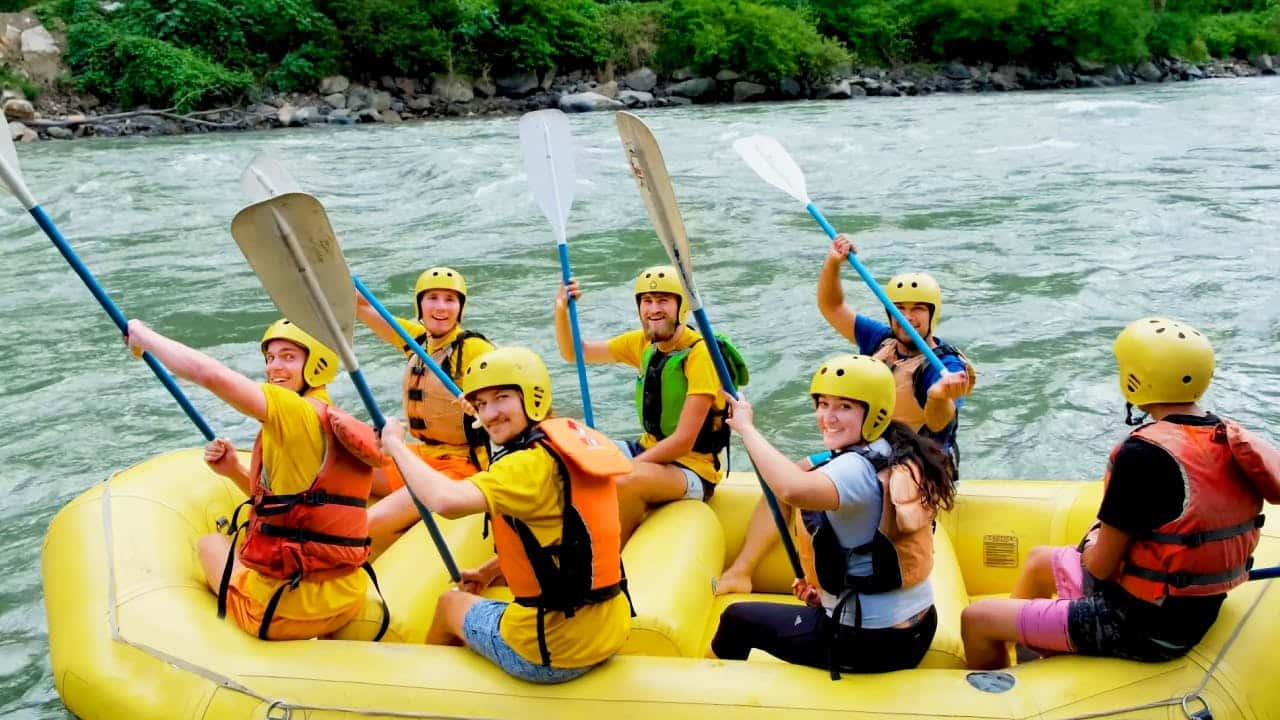
Book your Inca Jungle trek with Skyhook
What Activities Can You Do on the Inca Jungle Trek?
Other than trekking through the jungle, the stand-out activity of the Inca Jungle Trek is mountain biking. On day one, you will be cycling over two hours for 65 km / 40 miles down Malaga pass.
The possibility of white water rafting is another popular feature of this trek, which is greatly dependent on the season and river conditions.
Most river rafting tours are on fairly easy Grade II-III rapids, but some companies have the option for more challenging, Grade IV rapids.
Finally, you will have the option to include zip-lining and/or visiting hot springs in your adventure. Zip lining costs around $40 per person for 3-5 cables. Visits to hot springs cost $25 per person for the entrance fee plus transport costs.
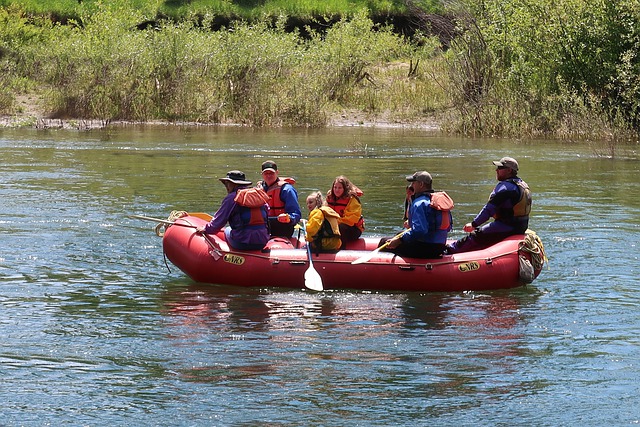
Where Do You Sleep On The Inca Jungle Trail?
Accommodation on the Inca jungle trek is usually in a hostel or home-stays. Hostels in the towns along the way are generally very basic but there are a few nice options.
In general, you will have access to electricity and running water (even if it is not always hot). On the last night, you will stay in a hotel in Aguas Calientes.
If you're staying elsewhere, there are also other accommodation options available:
All-inclusive and high-end tours offer much nicer accommodation with private rooms and quality meals.
Different companies partner with different accommodations. It is worth reading trip-advisor reviews online to see what travellers have to say about tour operators’ accommodation choices.
Inca Jungle Route Options and Maps
The Inca Jungle trek is usually completed on a 4 Day / 3 Night itinerary. The itinerary set out below is the most common, with subtle variations from tour company to tour company.
Inca Jungle Trek Variations
The 3 Day / 2 Night itinerary skips the trekking option between Santa Maria and Santa Teresa on day 2. Instead, car transport takes trekkers directly to Santa Teresa for zip-lining before continuing to Aguas Calientes.

Book your Inca Jungle trek with Skyhook
Day 1: Cusco – Abra Malaga Pass – Santa Maria
The Inca Jungle trek starts with a 3-4-hour drive to the top of the impressive Abra Malaga Pass (4,316m / 14,160 ft).
Most tour operators will either pick you up at your hotel in Cusco, or you will be asked to meet at the offices of the tour agency for collection. Departure times vary, but you will usually be on the road by 07:00.
The drive heads north out of Cusco (3,400m / 11,155 ft) and passes through the town of Chinchero before dropping into the Sacred Valley, where you can engage in some fun activities during your trip. Here, you will get your first glimpses of the Cordillera Urubamba, be prepared to be impressed.
You will cross the Urubamba River into the town of the same name and continue onwards to Ollantaytambo (2,792m / 9,160 ft). Some tour operators stop here for breakfast. After eating, you will continue onwards and upwards along a very windy road to the top of the Abra Malaga Pass.
The Abra Malaga Pass is the highest point on the trek (4,316m / 14,160ft) and provides incredible vistas down into the highlands (see pics below).
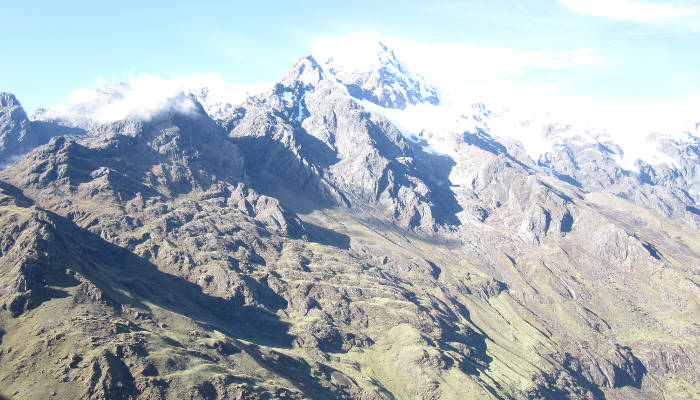
Mount Veronica (5680m / 18635ft). Veronica is the highest peak in the Cordillera Urubamba range. Its Quechua name is Wakay Willca, which means “Sacred Tears”. This image was taken from the other side of the Sacred Valley, near Abra Malaga Pass
You will disembark at the top of the pass to gear up for one of the most exciting bike rides of your life. The route from the top of Malaga Pass to the final destination is all downhill. A jaw-dropping 4,316m (14,160ft) to 1,196m (3,924 ft) descent – and just under 60km (37.3 miles) in distance. Most people take 4-5 hours to cycle this section.
The ride is not very strenuous though. You can free-wheel most of the way and will use the brakes more than the pedals. However, the many bends in the road can make it a little dangerous, so please take care.
The windy route has multiple blind corners. Cars on the route are few and far between (thankfully) but drive like maniacs!
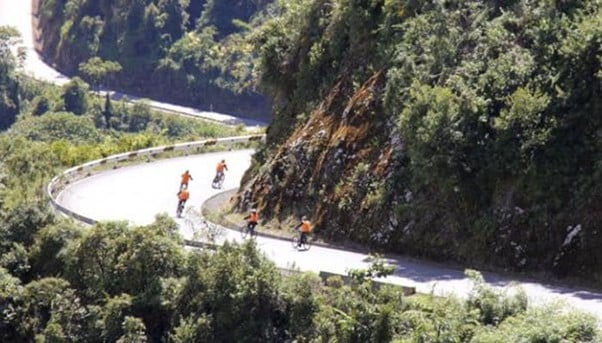
Biking on the Inca Jungle Trek
Make sure your tour company provides high visibility vests, reliable mountain bikes, and protective gear. A full-cover helmet is essential and you should be offered body gear too. The latter might be overkill for some people, but it’s better to play it safe.
A nice touch to these bike rides is that a backup vehicle usually drives in front of you. If you get tired or wish to stop, you can jump in the car.
Please Note: Back-up vehicles are not available with all tour companies. Cheaper tours may not include this option.
You will stop to have lunch en route and arrive at Santa Maria (1,196m / 3,924 ft) mid-to-late afternoon. If there is time and the season is right (typically October-April), you can go river rafting.
River rafting is an optional extra offered by some tour operators and is sometimes charged separately. The cost is around US$50 per person.
Please Note: Visibility is sometimes very poor on the Abra Malaga Pass. If there is heavy fog, your tour company will likely cancel the cycling excursion. Instead, you will drive directly to Santa Maria.
After your cycling tour, you will spend the night in Santa Maria. Your stay is usually organized with a local hostel, so don’t arrive with any expectations of luxury.
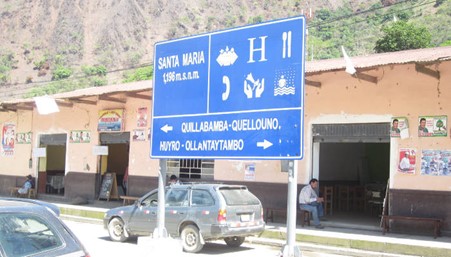
Santa Maria
Day 2: Santa Maria – Santa Teresa
Wake up in Santa Maria for an early breakfast. The second day is a relatively big trekking day in terms of distance (~15 km / 9.3 miles), but all at low-altitude.
The trek begins with a steep and strenuous climb that gradually flattens, before continuing through a number of undulating trails, one of which is an authentic Incan trail.
The scenery is lush with vegetation as you are in fact in the jungle region of Cusco. Remember to wear insect repellent, and look out for nasty little sand flies that leave itchy, red bites that can last for weeks.
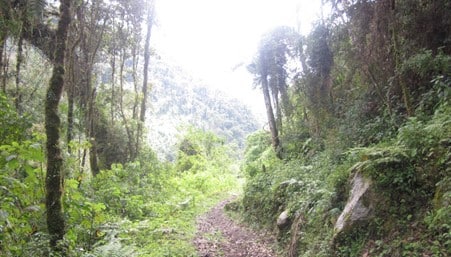
Lush tropical forest vegetation as seen on the Inca Jungle Trek.
On the trail, you will see coca, coffee, and various fruit tree plantations – everything grows in the jungle! After lunch and 6-7 hours of trekking, you will reach Cocalmayo, which is known for its hot springs.
Most trekkers stop here for a dip, so do remember to have your bathing suit at hand (see our packing list below). From the hot springs, the walk to your hostel at Santa Teresa (1,550m / 3,773 ft) is only 30 minutes.
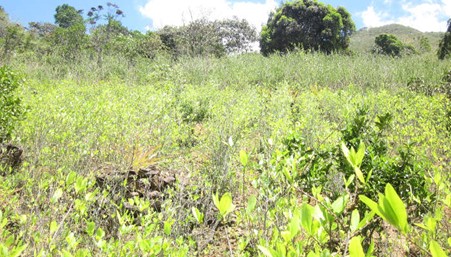
Coca leaf plantation as seen on the Inca Jungle trek.
Day 3: Santa Teresa – Hydroelectric Station – Aguas Calientes
On day 3, adrenaline junkies can try their hand at zip-lining.
The zip-lining option is sometimes included as an optional extra on tour packages. Make sure you check if zip-lining is included in your tour price when you make your booking.
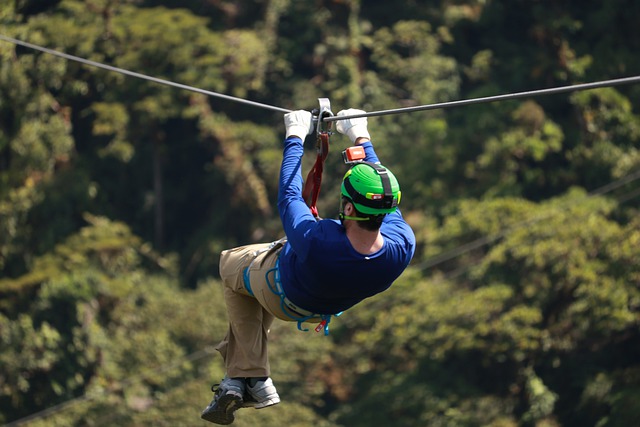
If it is an optional extra, the cost is around US$40 and includes transport to the zip-lines with 3-5 cable slides, the highest of which is 150m / 492 ft above the ground. Here’s a YouTube video from a previous trekker on his thrilling ziplining exploits.
After zip-lining, you will continue trekking for 2-3 hours to the Hidroeléctrica station. From Hidroeléctrica to Aguas Calientes, it is a 2-3 hour walk along the railway. If you are tired, you can catch a train to Aguas Calientes from the Hydroelectric station, which takes approximately 45 minutes and costs ~US$25.
If you opt out of zip-lining, you will start this trek first thing in the morning. You may also have to wait in Santa Teresa until zip-liners in your tour group have finished their airborne excursion.
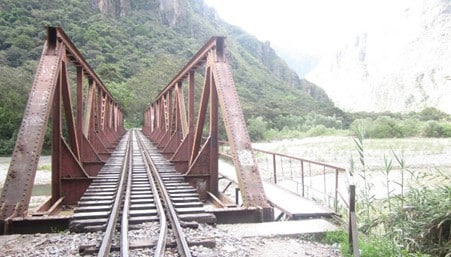
The route along the railway from Hydroelectric Station to Aguas Calientes.
Day 4: Aguas Calientes – Machu Picchu – Cusco
Day 4 usually starts with an early wake-up call from your hotel reception. This is to ensure you catch one of the first buses up to Machu Picchu. Buses start running at 05:30. It is a 30-minute ride to Machu Picchu, which opens at 06:00.
If you are trekking during the peak season (May-September), expect the queue for buses to start before 05:00. If you decide to get up early, it is likely because you are keen to see the sunrise from the Sun Gate (Inti Punku). This famous doorway is a good 40–60-minute walk up a gradual slope from the Citadel and well worth an early rising.
After arriving at Machu Picchu early (super early if you went for sunrise), you will then be given a 2–3-hour tour of the Citadel. These tours are typically arranged by your tour company. You will also get plenty of offers from tour guides situated outside the entrance of Machu Picchu.
Learn about Machu Picchu: See our epic Machu Picchu facts article.
Certified guides will have a card around their necks. Prices vary depending on the number of visitors in your group, so don’t be afraid to negotiate a little. Expect to pay around 40-50 Soles per person if there are 2 or more of you, and 80-100 Soles if it is just you.
After the Citadel tour of Machu Picchu, it is well worth hiking Huayna Picchu if you still have the energy and are not afraid of heights. The climb is steep and strenuous and takes the average trekker about an hour to reach the summit.
The views from the top are awesome and well worth the effort though. There are only 400 climbing permits a day, so you need to book early.
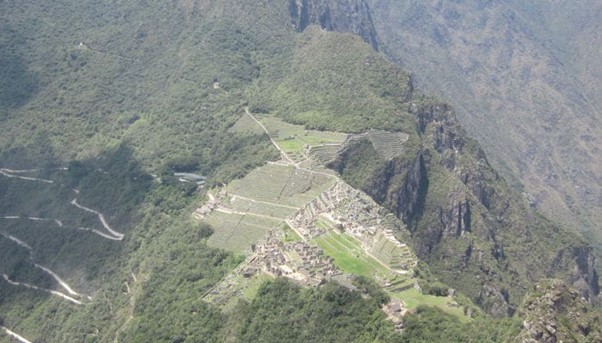
The view of Machu Picchu from Huayna Picchu (aka Wayna Picchu or Wayna Pikchu).
After visiting Machu Picchu, you will need to get a bus back to Aguas Calientes in time for your train journey to Ollantaytambo. Most tour operators organise your train ticket and provide a bus or private car to transport you from Ollantaytambo to Cusco.
If you are not using a tour company and are on a tight budget, it is possible to get a bus from the Hidroeléctrica Station to Cusco. This is a much longer route (7-8 hours).
See our article on how to get to and back from Machu Picchu here.

Book your Inca Jungle trek with Skyhook
Inca Jungle Trek Altitude and Route Maps
Below is the altitude profile for the Inca jungle trek. The highest point is the Abra Malaga Pass (4,350m / 14,271 ft). From here, there are several checkpoints which lead hikers and tourists to Machu Picchu (2,430m / 7,972 ft) and finally the return trip to Cusco (3,399m / 11,151 ft).
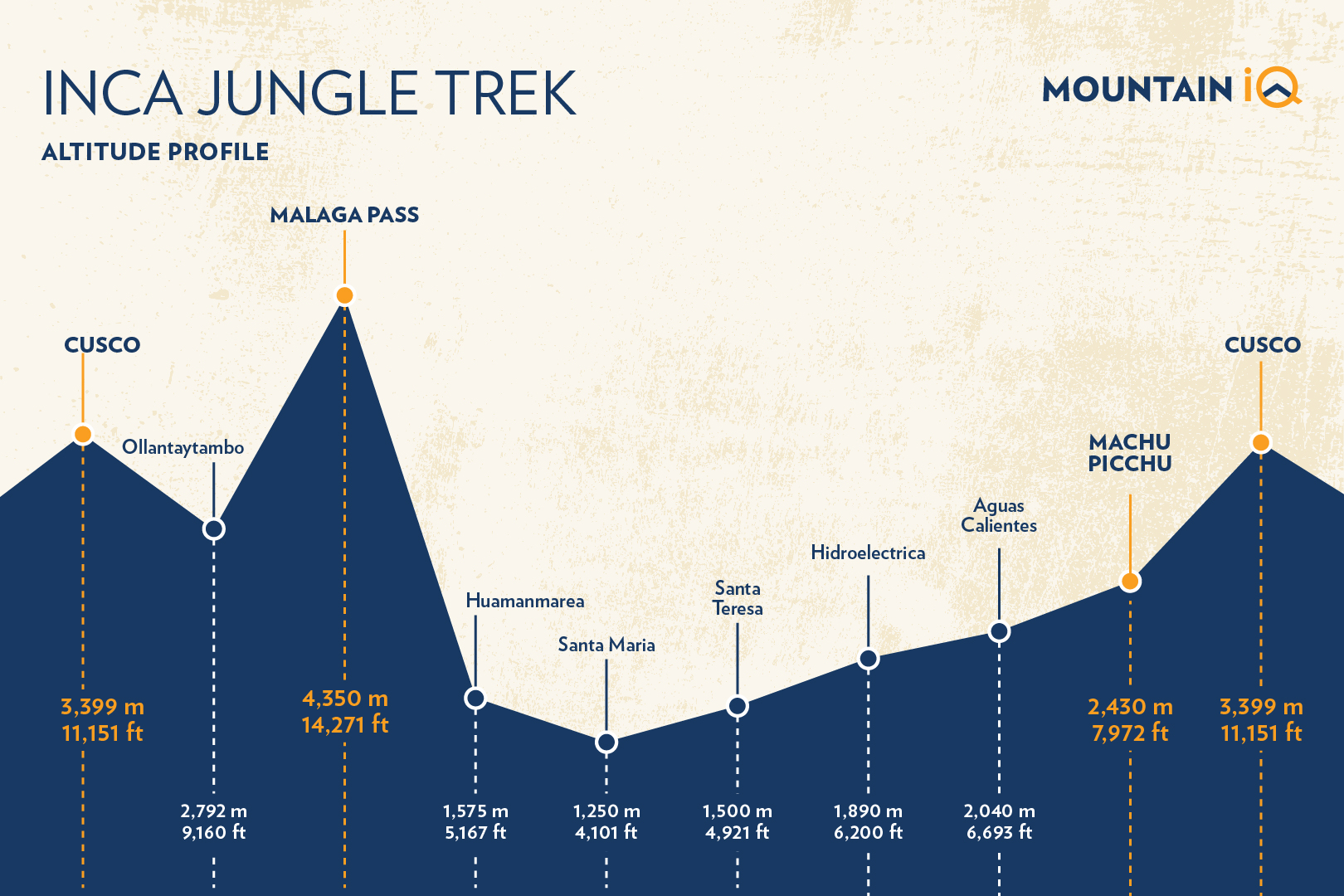
For more details on these various checkpoints, our handy Inca Jungle trek map below illustrates the route from Cusco, through the Sacred Valley, and then onto Abra Malaga. From here, trekkers can cycle to Santa Maria and then trek on foot to Aguas Calientes via Santa Teresa.
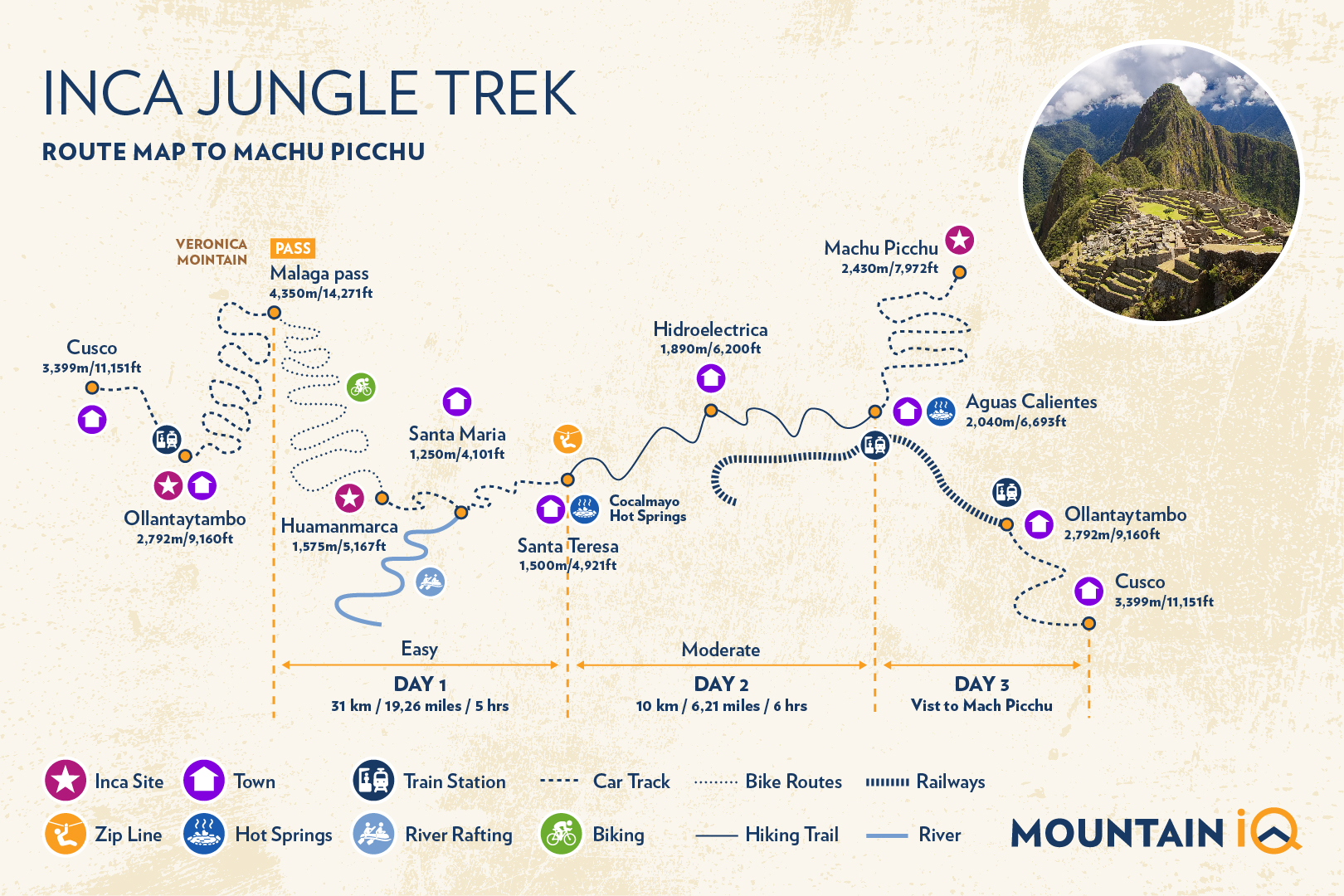
Should I Do The Inca Jungle Trail?
The trek naturally appeals to adventurous types who like thrilling adrenaline-filled experiences. Booking the Jungle Trail through a tour company allows you to do multiple activities in a few short days.
If you are looking for a pure Andean trekking experience and enjoy camping, then this trek is not for you. It is also not going to be fun for people who don't enjoy mountain biking or are afraid of heights.
Here are some alternatives:
- Alternative treks to Machu Picchu
- Classic Inca Trail (or conversely, the 4-day Inca Trek or Short 2-Day Inca Trail)
- Salkantay trek
- Lares Trek
- Vilcabamba Trek
- Tours of Rainbow Mountain and Humantay Lake
See all Machu Picchu routes.
Best Time for an Inca Jungle Trek
There are two main seasons in the subtropical Peruvian Andes:
- A dry season - May through to September
- A wet season - October to April
The Inca Jungle trek can be completed all year round. However, heavy rains during January and February often lead to landslides, which often affect the trail and road that connects Santa Maria with Santa Teresa. Because of this, the Inca Jungle trek is often closed between January and February.
The best time to do an Inca Jungle trek is either during the dry season or in the dry season shoulder months of March / April and October / November. The latter shoulder months are particularly good if you are keen to do some river rafting in Santa Maria.
The trail is busier during the dry season. That said, it never reaches the capacity of the Inca Trail, so you can still enjoy this amazing trek minus the usual crowds.
Temperatures are fairly consistent all year round, with warm days reaching temperatures of 20°C (68°F) and higher. The nights and early mornings are cold (with temperatures often decreasing to 0°C / 32°F and lower). In the dry season, temperatures sometimes drop below 0°C / 32°F too.
You will want to bring trekking clothing that you can layer up or down. Daily temperatures fluctuate and your body will heat up quickly when you’re active. See the packing list below for details on layering.
Finally, microclimates are the dominant weather force in the Andes. Make sure to bring some wet weather gear, like a basic poncho. It is possible to encounter rain at any time of the year.
For interesting historical weather charts of Machu Picchu, check out this article. Feel free to also check out our guide on Inca Trail temperatures for more general weather conditions along the trail.
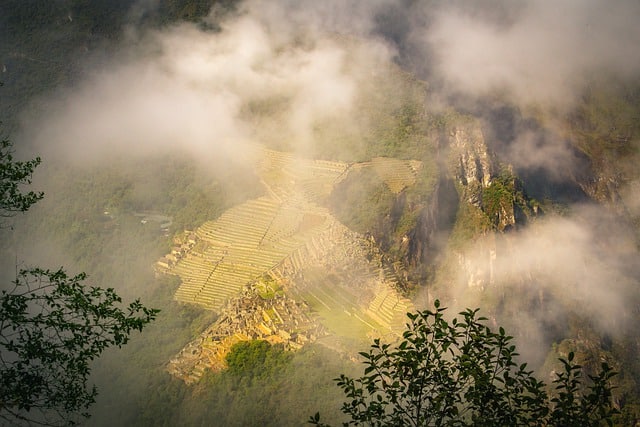
Can I Get Altitude Sickness on the Inca Jungle Trail?
The Inca Jungle trail is technically a high-altitude trek. In reality, the amount of time you spend at altitude is very short.
The highest altitude you will reach is Abra Malaga Pass at just over 4,300m / 14,108 ft. From this point, you will descend relatively quickly while cycling. You will end the day at a rather low altitude for the Andes, just under 1,200m / 3,937 ft.
For the rest of the tour, the trail undulates but never goes higher than 2,000m / 6,562 ft. Machu Picchu itself sits at 2,430m / 7,972 ft, which is still relatively low.
This means that altitude sickness on the Inca Jungle trail is rare. It’s nowhere near as prevalent as some of the other trails in this region where trekkers spend good portions of time hiking over 4,000m / 13,123 ft passes.
You are in fact at greater risk of succumbing to altitude sickness symptoms before you start the trek. Most visitors to Machu Picchu first fly into Cusco, which is situated at a high altitude of over 3,400m / 11,155 ft.
Experiencing mild altitude sickness, like a headache or nausea, is common for visitors in Cusco. It is important that you spend a few days acclimatising at this altitude before going any higher.
Another good option, if you have the time, is to immediately descend from Cusco into the Sacred Valley, which is a good 1,000m / 3,281 ft lower. You can rest here for a few days before returning to Cusco to join your Inca Jungle trek tour group.
We have written a detailed guide on acclimatization and altitude sickness which we recommend you take a moment to read.

Book your Inca Jungle trek with Skyhook
Looking for a day tour? Here are my 5 favourite day tours around Cusco:
- Rainbow Mountain day trip
- Moray and Salt Mines Quad Bike Tour
- Sacred Valley day tour
- Humantay Lake day tour
- Machu Picchu and Huayna Picchu entrance tickets
See more Cusco day trips.
Inca Jungle Trek Packing List
The packing list for an Inca Jungle trek is very similar to that of the Inca Trail trek. We have written a very detailed guide on the required gear for an Inca trail trek, and we suggest you use this as a template for the Inca Jungle trail.
The key difference for the Inca Jungle trek is that you will not be camping. You won’t need a sleeping bag or thermal mat as blankets will be provided at the hostels in Santa Maria and Santa Teresa.
See more on our recommended Packing List.
How Fit Do You Need to Be for The Inca Jungle Trek?
The Inca Jungle Trek is a diverse adventure with many different activities - trekking, cycling, white-water rafting, and zip lining. The trek is definitely better suited for the young-at-heart adventure seeker.
The mountain bike ride is all downhill which means even less experienced cyclists can manage this trek. The total hiking distance for this trip is 49km / 30 miles over three days. A lot of this trek is over flat terrain with no high-altitude passes.
In conclusion, some fitness is helpful but there’s no need to overdo it in preparation. If you are not already partaking in some form of exercise regime, you can check out our Machu Picchu trek training program.
Costs of Inca Jungle Trek
Over the last few years, the number of trekking companies offering the Inca Jungle trek has increased significantly.
Some operators have great offers, use fantastic cycling equipment and provide a brilliant service overall. However, as the route is not regulated, there are a few sharks in the market to watch out for. These guys offer cheap tours that definitely cut corners (hopefully not ones on Abra Malaga Pass!).
Prices for the Inca Jungle trek range from US$250 per person with the cheapest operators to US$700 per person with the best operators. Overall, it’s a good idea to budget between $400-$600 for a typical Inca Jungle Trek tour.
Inca Jungle Treks usually include:
- Transport throughout the trek.
- Hostels on the trek and a night in a hotel in Aguas Calientes.
- Cycling equipment.
- River rafting guides and equipment (not always included).
- Machu Picchu entrance ticket.
- The train or car journey back to Cusco after the tour.
The following are usually excluded from your Inca Jungle Trek Price:
- Zip-lining ($40)
- Bus to Machu Picchu ($24)
- Hot Springs ($50)
- Climbing Huayna Picchu / Machu Picchu Mountain ($25)
Alternatively, it is possible to get an all-inclusive tour. Prices for an all-inclusive tour range from US$1,000-US$1,500. This would include two nights in a hotel in Cusco to acclimatise and airport transfers.
This is in addition to all the features of the best tours set out above. Plus, you will spend a further night in Cusco after the trek.
Please Note: The best trek operators will have much better equipment, service, accommodation, and guides. So, it’s a better idea to choose a reputable tour operator with good services and who compensates their support staff (office admin, guides, porters and chefs) well.
Trekking Insurance For The Inca Jungle Trek
Insurance for your trek to Machu Picchu is a must since most operators will require you to carry sufficient travel insurance for your trek.
Make sure that the insurer you choose covers mountain biking and white-water rafting. I have reviewed a number of travel insurance providers and the most affordable and best by far is Rise & Shield.
Use the Calculator below to get a travel insurance quote for your trek.

Book your Inca Jungle trek with Skyhook
Conclusion
I hope you have found this article on the Inca Jungle trek useful. If you still have any questions or would like to provide some feedback, please leave a comment below. We would love to hear from you and will usually respond within 24 hours.
Tags: Inca Jungle Trek, Inca Jungle Tour, Inca Jungle Trail Machu Picchu, Inca Jungle Trek Review, Jungle Tour Machu Picchu, Jungle Trek Cusco, Machu Picchu Jungle Trail, Inca Jungle Trek Reviews, Inca Trail Jungle Trek
